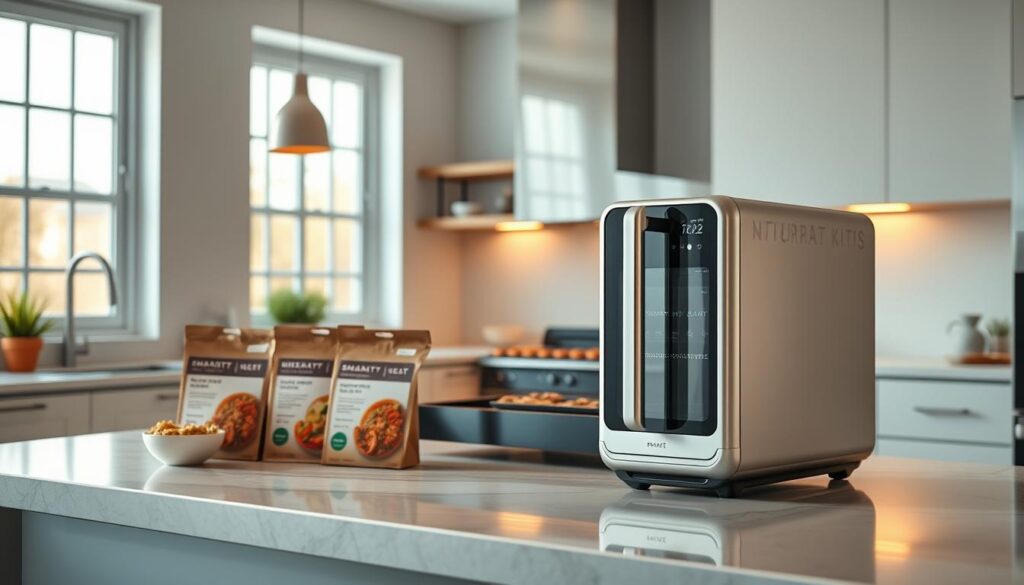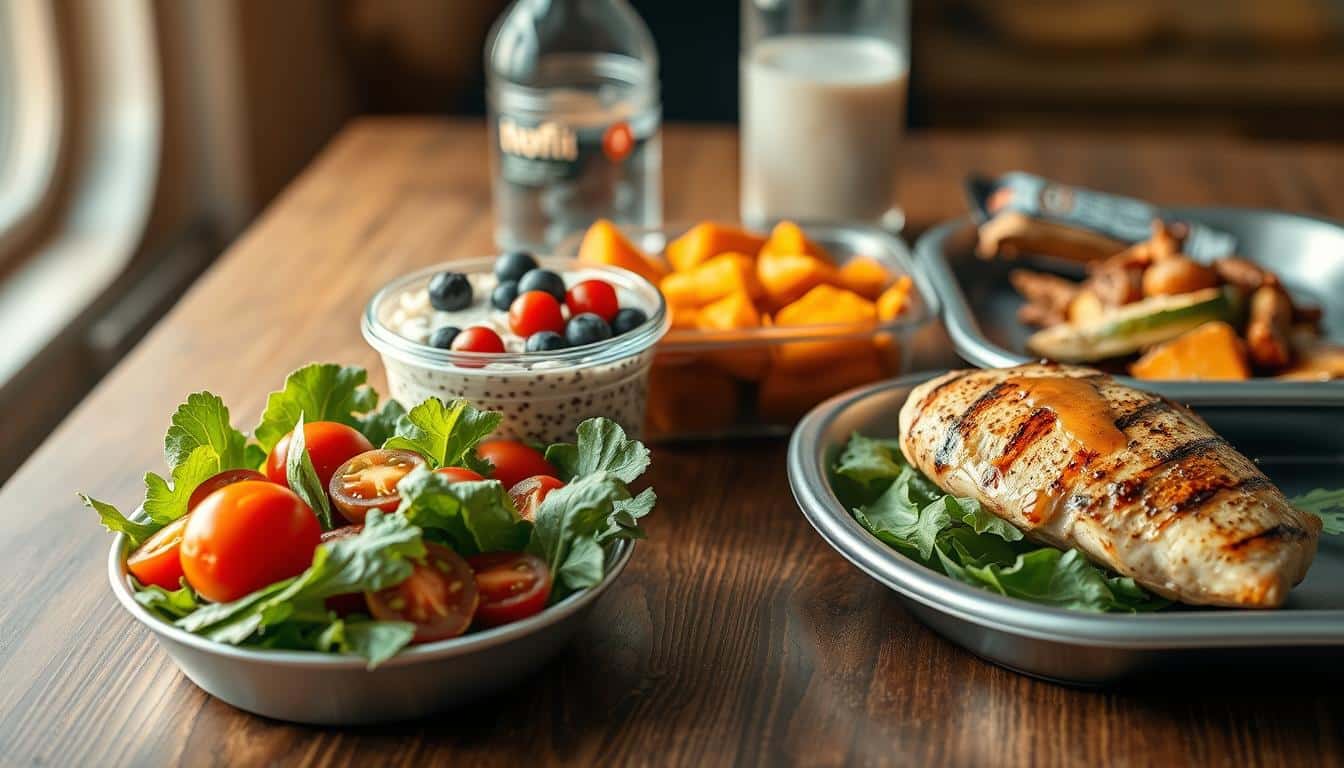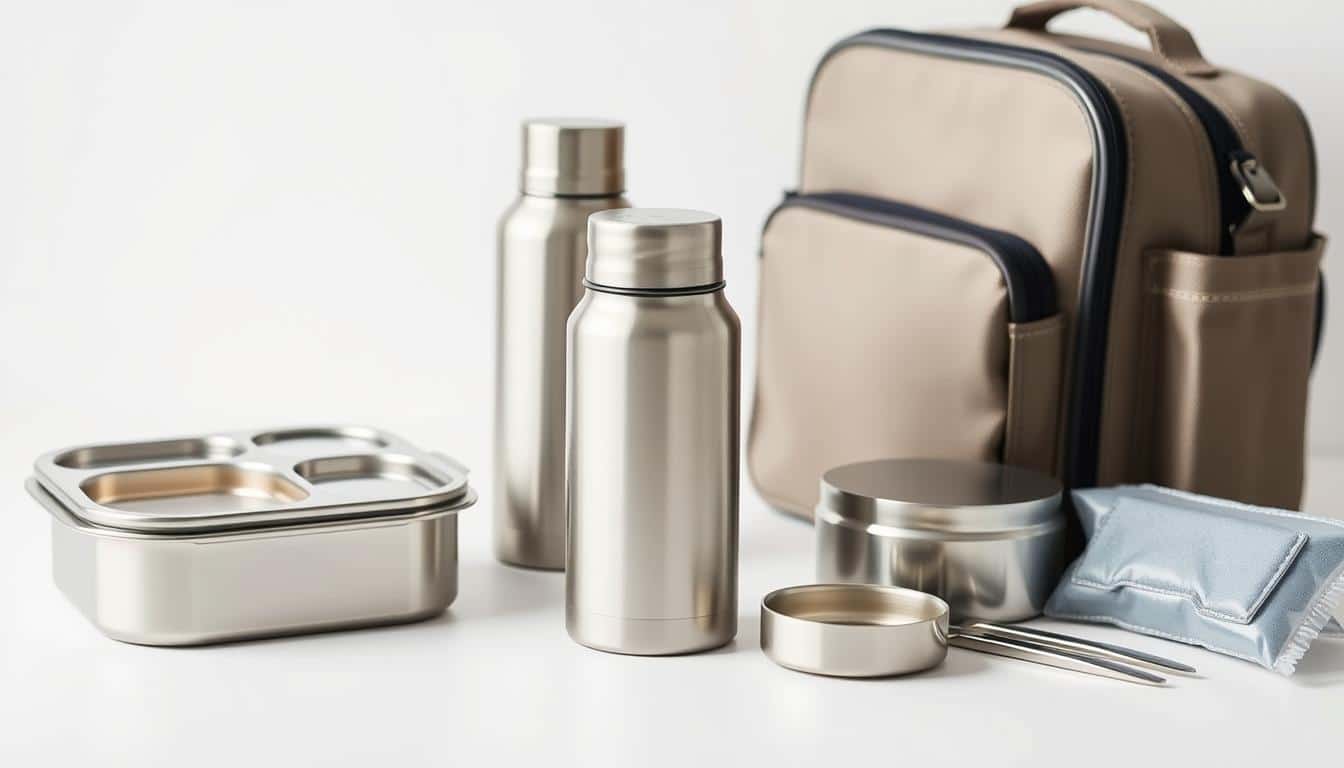Smart eating accessories are transforming the way Americans cook, eat, and plan their meals. These include connected tableware that tracks your food portions. Plus, smart dining tools sync with apps to help families save time and eat better.
The Thermomix TM7™ is a great example. It’s one device that pairs with Cookidoo® for guided recipes. It even has a built-in scale and connects via Wi‑Fi and Bluetooth. This gadget makes cooking complex dishes easy, ensuring consistent delicious results.
Then, there’s the smart toaster R180 Connect Plus with Wi‑Fi and bread presets. And don’t forget about meal-kit services and smart ovens like Tovala. They use QR codes and compact meal boxes to make dinner prep quicker. All these tools work together to make cooking precise, easy to repeat, and stress-free.
This article will show how smart eating accessories are a fit for American homes. We’ll give real examples, show their benefits, and help you find tools that suit your lifestyle.
What Are Smart Eating Accessories and Why They Matter
Smart eating accessories include things like connected plates, utensils, and devices that work with apps. They make mealtime smarter by saving time and making less work for you. This new tech makes cooking and eating simpler and more efficient.
Definition and examples of smart eating accessories
Smart eating accessories are items that use data or automation to help with eating and serving. There are smart utensils that track how much you eat and digital plates that know how much your food weighs. Devices like the Thermomix TM7™ mix, cook, and provide recipes, making them a key part of your kitchen.
How connected utensils and devices change mealtime routines
Using connected utensils and devices makes cooking easier by doing some steps for you. For instance, some ovens let you scan a meal’s code and then they set the right cooking time and temp. This tech shifts the work from watching over food to simply getting it ready, then letting your phone tell you when it’s done.
Benefits for busy, health-conscious U.S. households
- Time savings from preportioned meal kits and devices that auto-configure settings.
- Improved portion control using scales and portion-aware plates.
- Reduced decision fatigue through curated recipe platforms like Cookidoo® and connected appliance guidance.
- Consistent outcomes that suit working families, students, and health-focused consumers.
Smart Cooking Appliances That Complement Accessories
Smart accessories are more useful with modern appliances. Kitchen devices connect to apps for better control. This improves speed and reliability in American kitchens.
All-in-one multicookers and connected counters: the Thermomix TM7™ example
The Thermomix TM7 does a lot: it chops, blends, steams, and browns. It has a built-in scale and a big touchscreen. You get step-by-step guided recipes.
It connects to Cookidoo for over 100,000 recipes and more. This makes cooking easy to organize with your TM7.
The TM7 works well with smart tools or special plates. Easy to clean parts and a big steaming attachment are great for families. It has Wi-Fi and Bluetooth for up-to-date recipes.
Smart toasters and ovens with Wi‑Fi features
Modern Wi-Fi toasters have presets, screens, and settings for all bread types. They save your preferences. You can also check on your toast with your phone.
App-connected ovens get rid of manual settings. Some work with meal kits for easy cooking. You get notified when it’s done. This avoids overcooking and stress.
How appliance connectivity (Wi‑Fi, apps) improves meal planning and consistency
Connected appliances make planning easy. A multicooker can create shopping lists. A smart oven follows app presets and lets you know when the meal is ready. This means fewer mistakes and better timing.
- Saved presets for breads and roasts improve repeatable results.
- Guided recipes sync with scales and timers to reduce waste.
- Push notifications help manage multitasking in busy households.
Smart eating accessories for healthier portion control
Smart tools simplify sharing a meal with family. They have built-in scales and software that ensure everyone gets a fair share. This tech takes the guesswork out of mealtime.
Digital plates and bowls with built-in scales
- Many smart plates and bowls can tell you how much your food weighs. They use tiny, accurate scales. This is similar to the advanced scale in the Thermomix TM7™, ensuring recipe precision.
- You see the weight of your food on a screen or app. It teaches you about proper serving sizes for proteins, carbs, and veggies. You won’t need a separate scale in your kitchen.
Connected portion-tracking apps and meal logging
- Meal logging apps connect easily with smart eating gear. When you serve something on a plate or bowl, it adds to your daily food diary.
- Apps like MyFitnessPal and Cronometer work well with these smart plates. They make tracking your meals and nutrition much easier, by using open systems or CSV files.
Real-world use cases: family meals and weight management
- Parents love using smart plates for serving everyone equal amounts. It helps prevent overeating and makes meal planning easier.
- With smart plates, meal kits and services like Tovala are more effective. By scanning or weighing your food, you keep your meal logs precise.
- Weight management programs get better when they use data from smart dishes. This information helps coaches or trainers see your progress more clearly.
Smart utensils and cutlery that track nutrition
Smart forks and spoons are now found at dinner tables, not just concept stores. They have sensors to track how much and how fast you eat. They also estimate the calories in each bite. This tech helps eaters chew more slowly and take smaller portions.
Sensors that measure bites, calorie estimates, and eating speed
These advanced sensors track motion, acceleration, and how long contact lasts to count bites and guess portion size. They use this info along with food types to estimate calories. While results can vary, better sensors are making these guesses more accurate for daily use.
Integration with health apps and wearable devices
- These tools can connect with health apps like Apple Health or Google Fit, adding eating data to your health metrics.
- They also work with meal-planning apps, helping refine your calorie goals and meal times.
- Using readings from these utensils along with smart scales, you get a complete view of what you eat and cook.
Benefits for mindful eating and managing chronic conditions
Tools for mindful eating provide instant feedback, helping users eat more slowly and recognize when they’re full. For those with diabetes or high blood pressure, detailed records help doctors tailor treatment better. Families working on healthy eating find these smart forks helpful for eating less by curbing quick, mindless eating.
Using smart cutlery fits into a larger picture of connected kitchens. By linking with recipes or fitness devices, users easily get useful insights. This makes smart utensils a practical choice, beyond their novelty.
Smart kitchen scales and integrated recipe guidance
Nowadays, built-in scales in appliances are changing the way we cook at home. They let us measure ingredients right on the device. This reduces the need for extra bowls and spoons, making cleanup easier. Such convenience adds a natural touch of precision to meal preparation.
Precision weighing for accurate cooking and portioning
Precision in weighing is crucial because a few grams can change a dish’s texture or taste. Having a scale in a multicooker takes away the guesswork. This is a big help for portion control and getting consistent results, which is great for families watching their diet or following recipes closely.
Guided cooking synergy with platforms like Cookidoo®
Guided cooking combines precise measurements with step-by-step guidance. Cookidoo® and similar platforms offer recipes that use exact weights. When your appliance can read the weight of ingredients, the software adjusts cooking times and settings. This ensures the food turns out great every time.
How built-in scales in appliances (e.g., TM7™) streamline recipes
The Thermomix TM7™ has a built-in scale that enhances guided cooking. It uses accurate weights for every cooking step. Then, it automatically adjusts temperature, time, and speed. This makes prep quicker and cuts down on the need for other kitchen tools.
- Less cleanup: no extra bowls or measuring cups.
- Better consistency: guided cooking that reacts to real weights.
- Efficient meal kits: pre-portioned boxes pair well with on-device weighing when exact measures matter.
Smart meal kits and connected ovens for effortless dinners
Meal planning has seen a revolution with compact meal boxes and smart countertop appliances. These innovations focus on making dinners fast and simple. By combining smart meal kits with connected ovens, families save time and get great results, every time.

How meal boxes are designed and labeled is key for easy storage and fridge organization. They’re made to stack neatly and come with clear labels and windows. This takes the guesswork out of finding what you need, and the packaging is mostly recyclable.
- Compact boxes that stack for tidy refrigeration.
- Labels and visible windows for quick identification.
- Most packing materials are recyclable; small films may not be.
Smart ovens have added a new level of convenience with QR code reading. They scan the meal’s code and automatically adjust the settings. This makes cooking simpler and ensures meals are cooked perfectly every time.
Tovala has made it easy to go from box to oven with minimal prep. Most meals are ready in under six minutes, and cooking takes about ten to twenty minutes. It’s a game-changer for busy people.
- Scan the code, load the tray, press start.
- Phone notifications alert you when cooking is done.
- Some rare issues include mild overcooking or seasoning adjustments.
Today, making quick dinners relies on smart technology for speed and consistency. People love the quick prep, automatic settings, and alerts that keep them away from constantly checking the stove. These innovations aim to make dinner time less of a chore.
Systems like Cookidoo® and smart meal kits with QR-code ovens share a common mission. They simplify cooking after a long day, making it easy and enjoyable for everyone. It’s about turning weeknight dinners into something families look forward to.
Smart accessories for multi-level and multi-course cooking
Multi-level cooking changes how we make dinner. Small gadgets let one machine cook a whole meal at once. Think steamed veggies, seared meat, and a hot dessert all prepared together.
Steaming attachments imitate Varoma steaming and increase how much you can steam. With something like the Thermomix TM7™, you can steam fish, rice, and vegetables together. Each type of food keeps its moisture, nutrients, and flavor.
Modern kitchens often have tools for cooking proteins and sides at the same time. There are tiered inserts, holey trays, and special racks for multicookers and ovens. These tools let you cook your main dish and sides in one go, which saves time and power.
With multi-level cookers, you can truly cook multiple courses at once. Put a roast in the bottom, potatoes in the middle, and veggies or custard on top. Everything finishes cooking at the same time, perfectly done.
- Stackable trays make batch cooking and meal kits easy.
- Perforated inserts let steam distribute evenly.
- Special racks are designed for most smart ovens and multicookers.
In small homes, kitchen gadgets that save space are key. A single appliance with multi-level options can take the place of many pots and pans. This makes more room on your counters and cuts down on clean-up time.
For families on the go, using multi-level cookers with tools for cooking everything at once is a game changer. It lets parents prep quickly, cook everything at once, and serve hot, nutritious meals without a hassle.
Smart eating accessories and sustainability
Smart kitchen tools lower waste and encourage greener living. High-end appliances are made to last, with replaceable parts. This approach reduces the need for single-use items.
Pairing gadgets with smart meal planning helps avoid food waste and saves money.
Recyclable packaging and reduced single-use waste in meal kits
Meal-kit companies like Tovala focus on recyclable packaging. They use it for the main box, some insulation, and aluminum trays. However, some small parts are still not recyclable.
Clear labels and exactly measured ingredients make it less likely to waste food.
Durable, dishwasher-safe accessories and easy cleaning practices
The Thermomix TM7™ offers dishwasher-safe parts. It includes reusable spatulas and durable mixing bowls. This helps avoid single-use plastics.
Following simple maintenance and descaling tips keeps appliances working well for longer.
How smarter planning and portioning reduce food waste
Online recipe platforms and smart portioning tools adjust cooking to match what households need. This helps avoid buying too much and wasting food.
Smart scales and timers assist in meal planning. This makes it simpler to use food wisely and avoid waste.
- Choose eco-friendly meal kits with clear recycling guidance.
- Invest in sustainable smart accessories built for longevity.
- Prefer dishwasher-safe smart gadgets to simplify cleaning and reuse.
Design, safety, and maintenance of smart accessories
Smart eating accessories blend plastics, stainless steel, silicone, and electronics. Choose items with food-grade materials and clear cleaning instructions. This protects both performance and health. Look for labels showing dishwasher-safe smart gadgets when picking plates, lids, and parts that come off.

For a long life, follow simple cleaning rules. Bowls, lids, and trays marked as dishwasher-safe save you time. Clean the bases, touchscreens, and metal contacts with a soft, damp cloth. Stay away from harsh cleaners and rough pads. They can hurt the coatings and sensors.
- Clean sealing rings and gaskets after each use, and let them dry before putting them back.
- Run descaling cycles for appliances that use steam or hot water to stop mineral buildup.
- Keep fragile accessories in a dry, well-aired spot to avoid mold and warping.
When cooking with connected devices, electronic safety is key. Make sure ventilation holes are open for good air care. This reduces the workload on fans. Checking vents now and then stops lint and food bits from blocking the airflow.
Modern multicookers and smart toasters usually have overheat protection. But, relying only on electronics is not wise. Inspect cords, plugs, and cases for damage. Always unplug before deep cleaning. For repairs, reach out to authorized service places. Taking care of your appliance this way increases its life and lowers fire risks.
Be gentle with display screens. To clean touchscreens, use a soft microfiber cloth with a little water. Avoid dunking bases or wetting inside electronics. Follow the maker’s advice for surfaces that read QR codes. This ensures scans stay precise.
- Inspect power cords every three months for any damage.
- Keep to the descaling schedule in the manual for steam-based gadgets.
- Change out old seals and filters as advised to keep your smart accessory safe.
Quickly unpack meal-kit boxes and reusable inserts. Put labeled containers in the fridge so you can see them. Split up recyclable stuff for curbside pickup. These easy steps help keep your appliances in good shape. Plus, they avoid clutter that can block vents.
Shopping guide: choosing smart eating accessories for your lifestyle
Picking the right smart eating accessories involves looking at features, cost, and support. This guide helps U.S. shoppers weigh options like device connectivity, size, app options, and support after buying. It’s made to help you find kitchen tools that fit your daily life and future goals.
- Connectivity: Bluetooth is good for simple connections. Wi‑Fi updates device software and shares recipes across devices.
- Capacity and fit: Make sure to check the size of bowls and plates for your meal needs. Also, check if parts are safe for the dishwasher for an easy clean.
- App ecosystem: Search for apps with lots of recipes, ways to track portions, and can work with health apps.
- Included services: Services like Welcome Service or guided help can make it easier to learn how to use complex devices.
Budget tiers and tradeoffs
- Entry-level: Cheaper smart utensils and scales work well for casual users. These often have fewer preset options and simpler screens.
- Mid-tier: These devices have Wi‑Fi, more presets, and better apps. Some toasters, for instance, go from basic to ones that connect and have many settings for bread.
- Premium: Top-of-the-line multicookers and toasters offer complete app control, live classes, and more features. Buying something like a Thermomix TM7 will cost more but comes with lots of services.
Smart utensil price tiers
When looking at smart utensil prices, consider battery life, how accurate the sensors are, and if you can get replacement parts easily. Mid-range utensils usually offer a good mix of price and features. The most expensive sets offer detailed analysis and can sync with the cloud for tracking what you eat.
Where to buy and warranty considerations
- Manufacturer sites: These are good for special deals, getting started help, and registering for warranty directly.
- Major online retailers: They provide fast shipping and customer reviews to help you choose quickly.
- Specialty kitchen stores: Their staff can show you how things work and help you compare things directly.
Before buying, make sure to check warranty details and return options. Look into how long the warranty lasts, what parts it covers, and if setup help comes with delivery. With appliances like the Thermomix TM7, remember there’s a 2-year limited warranty from the manufacturer and extra options for recipe help.
This smart kitchen buying guide is here to help you decide where to buy smart eating accessories in the USA. Also, think about which price level is right for you. Keep in mind warranty and setup help to protect your buy and ensure you’re getting a good deal over time.
Smart eating accessories
Smart utensils, scales, and appliances can work together for smoother cooking. They use Wi‑Fi, similar interfaces, and cloud-based recipes. This means quicker prep, less errors, and the same good results every time, whether it’s a normal dinner or a holiday meal.
How combining smart accessories creates a smarter mealtime ecosystem
A smart scale can adjust a recipe instantly when used with a guided appliance. It can also send portion sizes to an app that helps with nutrition and shopping. This connection cuts down manual work and makes cooking dependable for everyone.
Examples of accessory bundles: utensils, scales, and guided-cooking appliances
Accessory sets often include utensils, tools, and key appliances. For example, the Thermomix TM7™ might come with a Varoma set, mixing blade, and simmering basket. Some meal kits work with smart ovens that scan QR codes to cook food perfectly.
- Utensils with sensors for bite and pace tracking
- Digital plates and kitchen scales for exact portions
- Guided-cooking hubs that run recipes step-by-step
Maximizing value: free trials, guided classes, and bundled subscriptions
Trying a Cookidoo trial can show you thousands of recipes for a smart device. Some deals offer a 3-month Cookidoo trial plus cooking classes or special online sessions with chefs. These deals and subscriptions make it easier to learn and provide continuous benefits.
Seek out bundles that come with extra services like setup help or classes. Even a short trial and one class can make a hard recipe easy to do over and over. Making smart buys and using guided cooking helps users cook well without wasting anything.
Conclusion
Smart countertop devices now come in many varieties, from simple digital gadgets to those that connect to Wi-Fi. They have settings for special diets, such as gluten-free. These tools, along with smart utensils and scales, make cooking easier. They save time and take the guesswork out of meal prep. For busy households in the U.S., they mean quick meal prep, consistent cooking, and less wasted food.
The Thermomix TM7™ is a standout in connected kitchen appliances. It combines a scale, recipe guide, and multi-level steaming. It also has safety features. When used with smart plates and utensils, it helps make meals that are both tasty and easy to prepare. This device shows how the future of cooking might be about using one appliance. It could control serving sizes, cooking times, and methods.
Pairing meal kits with smart ovens offers tangible benefits. The kits come in recyclable, clearly marked boxes with simple 6-minute prep instructions. The ovens scan QR codes to automatically set the right cooking temperature. Dinners are ready in 10–20 minutes, and your phone tells you when. You might still need to adjust the seasoning, but these innovations help make healthier eating and weeknight dinners easier.
In summary, smart kitchen tools offer big advantages. They make cooking more efficient, support a sustainable lifestyle, and help you eat better. Starting to use these smart mealtime tools now could lead households to a future. A future where dining is both connected and tailored to our health goals and busy lives.
FAQ
What are smart eating accessories?
How do connected utensils and devices change mealtime routines?
What are the main benefits for busy, health-conscious U.S. households?
How does the Thermomix TM7™ fit into a smart accessory ecosystem?
Do smart toasters and ovens offer useful connectivity features?
How do built-in scales improve cooking and portion control?
What is the real-world experience of using meal kits with smart ovens?
Can smart utensils and plates integrate with health apps and wearables?
How do multi-level steaming attachments and accessories help family cooking?
What sustainability advantages do smart meal kits and accessories offer?
What are the maintenance and cleaning requirements for smart accessories and appliances?
Are smart eating accessories safe for people managing chronic conditions?
What should I look for when buying smart eating accessories?
How do product tiers and pricing affect feature availability?
Where can I buy smart eating accessories in the United States and what warranty should I expect?
How do smart accessories and meal kits together create a complete mealtime system?
Content created with the help of Artificial Intelligence.



